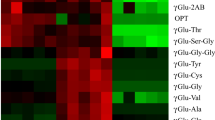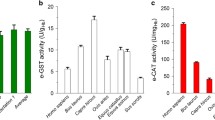Abstract
A glutathione transferase from human mononuclear leukocytes with a high activity towardtrans-stilbene oxide (GT-tSBO) has been studied in liver and blood from fetus and adults and in blood from neonates. Using starch gel electrophoresis, different phenotypes of GST1 have been determined, GST1 0, GST1 1, and GST1 2. As judged from activity measurements and the fact that only those individuals who express the null allele of GST1, the GST1 0, which has a low activity towardtrans-stilbene oxide, it is concluded that the hepatic transferase GST1 is identical to GT-tSBO, as well as to hepatic transferase μ. In addition, it has been shown that the different genotypes of GST1 1 (GST1 1-1, GST1 1-0) and GST1 2 (GST1 2-2, GST1 2-0) can be separated by measuring the GT-tSBO activity in whole blood from the same individual. It is also demonstrated that GT-tSBO activity is much lower in fetal liver, approximately 10 times, compared with adult liver, while this activity seems to be unchanged in the blood from fetus and adults, as well as in neonates.
Similar content being viewed by others
References
Awasthi, Y. C., Dao, D. D., and Saneto, R. P. (1980). Interrelationship between anionic and cationic forms of glutathione S-transferases of human liver.Biochem. J. 1911.
Board, P. G. (1980). A method for the localization of glutathione S-transferase isozymes after starch gel electrophoresis.Anal. Biochem. 105147.
Board, P. G. (1981). Biochemical genetics of glutathione S-transferase in man.Am. J. Hum. Genet. 3336.
Board, P. G., Suzuki, T., and Shaw, D. C. (1988). Human muscle glutathione S-transferase (GST-4) shows close homology to human liver GST-1.Biochim. Biophys. Acta 953214.
De Pierre, J. W., Seidegård, J., Morgenstern, R., Balk, L., Meijer, J., Åström, J., Norelius, I., and Ernster, L. (1984). Induction of cytosolic glutathione transferase and microsomal epoxide hydrolase activities in extrahepatic organs of the rat by phenobarbital, 3-methylcholanthrene andtrans-stilbene oxide.Xenobiotica 14295.
Faulder, C. G., Hirrell, P. A., Hume, R., and Strange, R. C. (1987). Studies of the development of basic, neutral and acidic isoenzymes of glutathione S-transferase in human liver, adrenal, kidney and spleen.Biochem. J. 241221.
Gill, S., Ota, K., and Hammock, B. D. (1983). Radiometric assay for mammalian epoxide hydrolase and glutathione S-transferase.Anal. Biochem. 131273.
Habig, W. H., Pabst, M. J., and Jakoby, W. B. (1974). Glutathione S-transferases: The first enzymatic step in mercapturic acid formation.J. Biol. Chem. 2497130.
Harada, S., Abai, M., Tanaka, N., Agarwal, D., and Goedde, H. W. (1987). Liver glutathione S-transferase polymorphism in Japanese and its pharmacogenetic importance.Hum. Genet. 75322.
Jakoby, W. B., and Habig, W. H. (1980). Glutathione transferases. In Jacoby, W. B. (ed.),Enzymatic Basis of Detoxication, Vol. 2 Academic Press, New York, p. 63.
Laisney, V., Van Cong, N., Gross, M. S., and Frezal, J. (1984). Human genes for glutathione S-transferases.Hum. Genet. 68221.
Mannervik, B. (1985). The isoenzymes of glutathione transferase.Adv. Enzymol. Relat. Areas Mol. Biol. 57357.
Mannervik, B., Ålin, P., Guthenberg, C., Jensson, H., Tahir, M. K., Warholm, M., and Jörnvall, H. (1985). Identification of three classes of cytosolic glutathione transferase common to several mammalian species: Correlation between structural data and enzymatic properties.Proc. Natl. Acad. Sci. USA 827202.
Seidegård, J., and Pero, R. W. (1985). The hereditary transmission of high glutathione transferase activity towardstrans-stilbene oxide in human mononuclear leukocytes.Hum. Genet. 6966.
Seidegård, J., DePierre, J. W., Birberg, W., Pilotti, Å., and Pero, R. W. (1984). Characterization of soluble glutathione transferase activity in resting mononuclear leukocytes from human blood.Biochem. Pharmacol. 333053.
Seidegård, J., DePierre, J. W., and Pero, R. W. (1985). Hereditary interindividual differences in the glutathione transferase activity towardstrans-stilbene oxide in resting human mononuclear cells are due to a particular isozyme(s).Carcinogenesis 61211.
Seidegård, J., Pero, R. W., Miller, D. G., and Beattie, E. J. (1986). A glutathione transferase in human leukocytes as a marker for the susceptibility to lung cancer.Carcinogenesis 7751.
Seidegård, J., Guthenberg, C., Pero, R. W., and Mannervik, B. (1987a). The trans-stilbene oxide active glutathione transferase in human mononuclear leukocytes is identical with the hepatic glutathione transferase μ.Biochem. J. 246783.
Seidegård, J., Pero, R. W., Jonsson, G. G., Olsson, S.-Å., Stavenow, L., and Aronsen, K.-F. (1987b). A human isozyme of glutathione transferase activity in different organs and its relation to lung cancer. In Benford, B., Bridges, J. W., and Gibson, G. G. (eds.),Drug Metabolism—from Molecules to Man Taylor and Francis, London, p. 106.
Seidegård, J., Pero, R. W., and Pearson, W. R. (1988). Hereditary differences in human glutathione transferase GT-tSBO expression are due to a gene deletion.Proc. Natl. Acad. Sci. 857293.
Singh, S. V., Kurosky, A., and Awasthi, Y. C. (1987). Human liver glutathione S-transferase ω. Chemical characterization and secondary-structure comparison with other mammalian glutathione transferases.Biochem. J. 24361.
Strange, R. C., Faulder, C. G., David, B. A., Hume, R., Brown, J. A. H., Cotton, W., and Hopkinson, D. A. (1984). The human glutathione S-transferases. Studies on the tissue distribution and genetic variation of the GST1, GST2, and GST3 isozymes.Ann. Hum. Genet. 4811.
Strange, R. C., Davis, B. A., Faulder, C. G., Cotton, W., Bain, A. D., Hopkinson, D. A., and Hume, R. (1985). The human glutathione S-transferases: Development aspects of the GST1, GST2, and GST3 loci.Biochem. Genet. 231011.
Suzuki, T., Coggan, M., Shaw, D. C., and Board, P. G. (1987). Electrophoretic and immunological analysis of human glutathione S-transferase isoenzymes.Ann. Hum. Genet. 5195.
Vander Jagt, D. L., Hunsaker, L. A., Garcia, K. B., and Royer, R. E. (1985). Isolation and characterization of the multiple glutathione S-transferases from human liver.J. Biol. Chem. 26011603.
Warholm, M., Guthenberg, C., and Mannervik, B. (1983). Molecular and catalytic properties of glutathione transferase μ from human liver: An enzyme efficiently conjugating epoxides.Biochemistry 223610.
Author information
Authors and Affiliations
Additional information
This study was supported by Svenska Tobaks AB, Grant 8617, Magnus Bergvalls Stiftelse, Marcus Borgströms fond, Greta och Johan Kocks Stiftelse, John och Augusta Perssons Stiftelse för vetenskaplig medicinsk forskning, och Direktör Albert Påhlssons stiftelse för forskning och välgörenhet.
Rights and permissions
About this article
Cite this article
Seidegård, J., Pero, R.W. & Stille, B. Identification of thetrans-stilbene oxide-active glutathione transferase in human mononuclear leukocytes and in liver as GST1. Biochem Genet 27, 253–261 (1989). https://doi.org/10.1007/PL00020159
Received:
Revised:
Issue Date:
DOI: https://doi.org/10.1007/PL00020159




